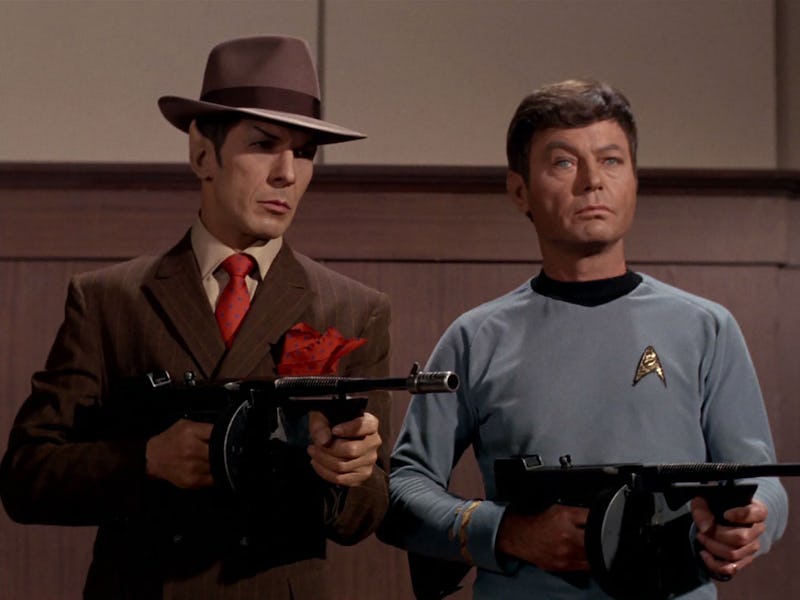Star Trek: Discovery's latest McGuffin is a reference to TOS space mobsters
What's broken on the Starship Discovery this time? A classic piece of faux Trek-tech!

In Star Trek II: The Wrath of Khan, Admiral Kirk tells young Lt. Saavik about learning about "why things work on a starship." But half the time in Star Trek, the reason why things work or don't work on starships is often because of some random made-up gizmo with a vaguely defined purpose.
Sure, the fictional science of Star Trek's warp drive is better-documented than the hyperdrive in Star Wars, but there's still plenty of crucially important tech with unclear functions in the world of Kirk and Picard. So if you think the Spore Drive on Discovery is the least-scientific thing on that show, you're actually quite wrong. Space mushrooms are closer to science fact than much of Trek's vague sci-fi tech. Specifically, the latest space Maguffin in Discovery — the Transtator.
Confused as to what is broken on the USS Discovery? Forgot what a Transtator is? Well, to understand this kooky sci-fi tech, you have to go back to an episode of Star Trek: The Original Series called "A Piece of the Action," better known to many fans as "The One With the Space Mobsters." Here's how this classic '60s Trek romp informed the sci-fi tech crisis in the newest Discovery episode.
Warning! Spoilers ahead for Star Trek: Discovery Season 3, Episode 2, "Far From Home."
"A Piece of the Action."
After the USS Discovery crashlands on a planet known only as "The Colony," Lt. Bryce (Ronnie Rowe Jr.) tells Saru (Doug Jones) that the ship needs one of its "transtators" totally rebuilt. Your eyes are not deceiving you. I did not misspell "translator." This Trek gizmo is called a transtator, and according to Trek lore, it is the "key" to all technology in the 23rd Century, the time period where the USS Discovery originates.
In the TOS episode "A Piece of the Action," Kirk and the USS Enterprise visit a planet called Sigma Iotia II, which is populated by old-timey mobsters. The reason this planet is run by mobsters who say things like "We're gonna put the bag on your Captain!" is because Spock says their culture is "highly imitative." A hundred years prior, a different spaceship left a book about the Chicago Mobs of the '20s, and boom, a century later, you've got Mobster Planet.
This is important for the latest Discovery episode not because there are space mobsters, but because of what happens at the end of "A Piece of the Action." As the Enterprise is leaving, having peacefully "fixed" Mobster Planet, Bones realizes that he left his communicator behind on the planet. Kirk and Spock are appalled, because, they know this "highly imitative" culture will likely discover the "transtator," which Spock says is the "key" to all of Starfleet technology.
The crew discuss the problem of the transtator in 'Discovery' Season 3, Episode 2. It's that ordinary-looking gizmo on the table.
But what does the transtator do? Well, it's been mentioned a bunch of times in Trek canon since then, but the best guess is that it's kind of battery combined with a super-advanced microchip. Basically, it's used to relay power throughout a starship. In the Deep Space Nine episode "Trials and Tribble-ations," a time-traveling Miles O'Brien accidentally disconnected a transtator on the classic Enterprise, which caused the lights to flicker.
In some ways, the transtator has been kind of a running joke in Trek. It's a piece of technology that is vital, but isn't really cool — sort of like a spaceship's version of a sparkplug. But in "Far From Home," the Saru, Tilly, and the crew of the Discovery desperately need a rebuilt transtator to restore power on the ship.
Spock using Rubindium to make a DIY laser in "Patters of Force."
So, what is the raw material the transtator is made out of? Here, there's another callback to classic Star Trek. Tilly mentions that the crew doesn't have enough raw "rubindium" to make a new transtator. You might think this is the real-life element called "rubidium," but they are different. Basically, rubidium is a real element and rubindium is not. In the TOS episode "Patterns of Force," Spock and Kirk are implanted with subcutaneous trackers called transponders, which are made of rubindium. After being thrown in a prison run by Space Nazis (yep!) Spock cuts open Kirk's and his own arm, pulls out the rubindium, and makes a Macgyver-style laser beam using the material and a lightbulb.
Without these two over-the-top episodes of Star Trek: The Original Series, the plot of the latest Star Trek: Discovery episode couldn't have happened. Considering "Far From Home" featured an outer space saloon and marauders who had to be brought to justice by the good people in Starfleet, Discovery might have more in common with The Original Series than ever before. Now we just need to see some 32nd Century space mobsters.
Star Trek: Discovery Season 3 airs new episodes on Thursdays on CBS All Access.